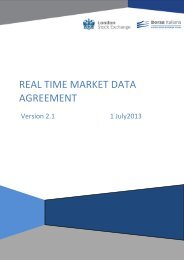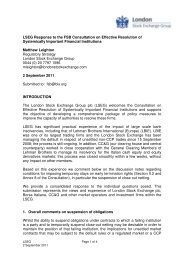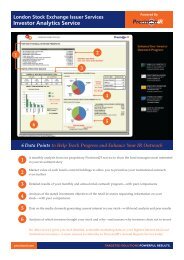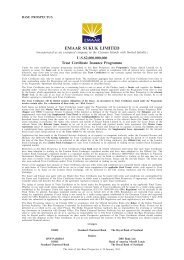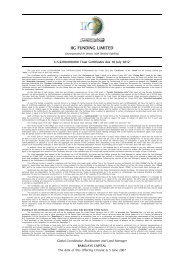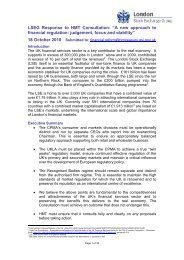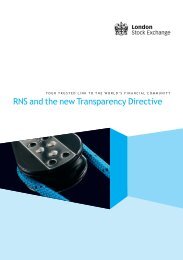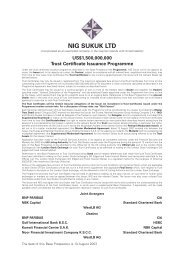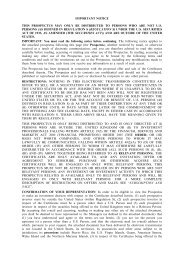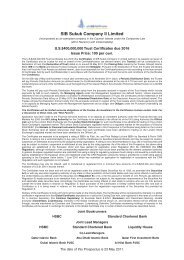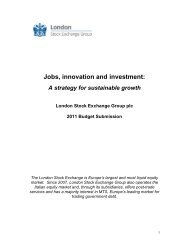Tabreed 06 Prospectus - London Stock Exchange
Tabreed 06 Prospectus - London Stock Exchange
Tabreed 06 Prospectus - London Stock Exchange
Create successful ePaper yourself
Turn your PDF publications into a flip-book with our unique Google optimized e-Paper software.
NATIONAL CENTRAL COOLING COMPANY (PJSC)<br />
NOTES TO THE CONSOLIDATED FINANCIAL STATEMENTS<br />
31 December 2004<br />
2 SIGNIFICANT ACCOUNTING POLICIES continued<br />
Impairment and uncollectibility of financial assets<br />
An assessment is made at each balance sheet date to determine whether there is objective evidence<br />
that a financial asset or group of financial assets may be impaired. If such evidence exists, the<br />
estimated recoverable amount of that asset is determined and any impairment loss recognised for the<br />
difference between the recoverable amount and the carrying amount. Impairment losses are recognised<br />
in the income statement.<br />
Inventories<br />
Inventories are stated at the lower of cost and net realisable value. Costs are those expenses incurred<br />
in bringing each product to its present location and condition, as follows:<br />
* Raw materials, consumables and goods<br />
for resale<br />
– purchase cost on a first-in, first-out basis.<br />
* Work in progress and finished goods – costs of direct materials and labour plus<br />
attributable overheads based on a normal<br />
level of activity.<br />
Net realisable value is based on estimated selling price less any further costs expected to be incurred<br />
on completion and disposal.<br />
Accounts receivable<br />
Accounts receivable are stated at original invoice amount less a provision for any uncollectible<br />
amounts. An estimate for doubtful debts is made when collection of the full amount is no longer<br />
probable. Bad debts are written off as incurred.<br />
Cash and cash equivalents<br />
Cash and cash equivalents comprise cash at hand, bank balances and short-term deposits with an<br />
original maturity of three months or less. For the purpose of the Statement of Cash Flows, cash and<br />
cash equivalents consist of cash and cash equivalents as defined above, net of outstanding bank<br />
overdrafts.<br />
Accounts payable and accruals<br />
Liabilities are recognised for amounts to be paid in the future for goods or services received, whether<br />
billed by the supplier or not.<br />
Provisions<br />
Provisions are recognised when the Company and its subsidiaries have an obligation (legal or<br />
constructive) arising from a past event and the cost to settle the obligation is both probable and able<br />
to be reliably measured.<br />
Term loans and Islamic loans<br />
The term loans and Islamic loans are carried on the balance sheet at their principal amount.<br />
Instalments due within one year are shown as a current liability. Interest on term loans and<br />
fluctuating profit charges on Islamic loans are charged as an expense or capitalised as part of capital<br />
work in progress in accordance with International Accounting Standard No 23 as it accrues, with<br />
unpaid amounts included in ‘‘accounts payable and accruals’’.<br />
Leases<br />
Finance leases, which transfer to the Company and its subsidiaries substantially all the risks and<br />
benefits incidental to ownership of the leased item, are capitalised at inception of the lease at the fair<br />
value of the leased asset or, if lower, the present value of the minimum lease payments. Lease<br />
payments are apportioned between the finance charges and reduction of the lease liability so as to<br />
achieve a constant rate of interest on the remaining balance of the liability. Finance charges are<br />
recognised directly in the income statement.<br />
F-48



